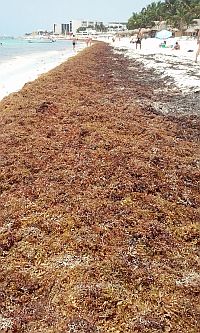Cancun, Quintana Roo - Mexico has spent $17 million to remove over half a million tons of sargassum seaweed from its Caribbean beaches, from Tulum to Playa del Carmen to Cancun. The problem - now affecting tourism and the environment (the plant is poisonous for some coral reefs, local fauna and fish) - isn't going away, experts said at an international conference last week.
Officials from Mexico, Honduras, Nicaragua, the Dominican Republic, Jamaica, Trinidad and Tobago, Haiti, Cuba, Panama, Guadeloupe, Belize, Guyana and Guatemala gathered in Cancun to discuss regional strategies to combat the sargassum that's invading beaches.
 |
"We are seeing a major impact on our countries, economically, socially," said Dr. June Soomer, secretary general of the Association of Caribbean States, the Associated Press reported.
Among the proposals presented, representatives called for extra support for research and the development of a warning system for the seaweed.
Dr. Soomer called for a revision of the Convention for the Protection and Development of the Marine Environment in the Wider Caribbean Region, a 1983 agreement commonly known as the Cartagena Convention. She also said that countries affected by sargassum need to look at different ways to obtain external funding, given that many of the smaller islands operate on small budgets.
Mexico's Quintana Roo Governor Carlos Joaquín González said long-term solutions to the problem are needed to stop the negative effects of the seasonal phenomenon on tourism, which is the economic backbone of most Caribbean countries. President Andres Manuel Lopez Obrador recently visited the coast after announcing he would not contract out the work of cleaning up sargassum, and instead will put the Mexican Navy in charge of building collector boats and cleaning the sea.
A floating barrier has been installed to prevent sargassum from reaching the shores of Playa del Carmen in Quintana Roo. The Navy said it will implement more of these barriers, as well as build four boats specifically designed to remove the seaweed.
Ricardo del Valle, a business owner in the seaside resort of Playa del Carmen, told the AP: "We offer sun and sand, nothing else. That is what we're selling. And right now, we're fooling our tourists."
In 2018, more than 1,000 square miles of seaweed were detected in satellite photos of the Caribbean, three times larger than the 2015 record, according to scientists at the University of South Florida's Optical Oceanography Laboratory. In fact, Barbados was forced to declare a national emergency.
Original article


